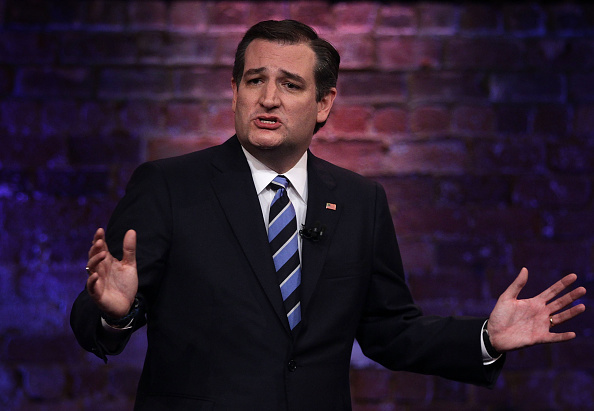
Under Texas Sen. Ted Cruz’s tax plan, all payroll taxes, the corporate tax, the estate tax, the gift tax, and the alternative minimum tax would be summarily abolished.
In their place, Cruz would impose two, fresh new taxes: a 10% flat tax on individual income, and what amounts to a 19% value-added tax, or VAT, on all business revenue.
It’s a politically risky move that has already ignited a feisty battle among the Republican base.
On the one hand, conservatives like the simplicity of Cruz’s plan—it scrapes away layers of complicated tax brackets, exceptions and loopholes. They also like that it would result in a tax break for most Americans, with nearly 80% of the juiciest goodies going to those in the top 20%, according to a recently analysis by the nonpartisan economic think tank, the Tax Policy Center.
On the other hand, ever since Ronald Reagan railed against the VAT, a type of sales tax, as a Trojan Horse for ever-higher new taxes and creeping socialism, Republicans have hated the very mention of it.
Now that Kentucky Sen. Rand Paul is out of the race, Cruz is the only candidate to propose a VAT—and the senator is taking heat for it. On the campaign trail and at the last Republican debate, Rubio promised to “side with Reagan” on the VAT and accused Cruz of imposing “kind of tax you find in Europe.” Zing.
Cruz hit back. His version of the VAT—which he prefers to call a “a simple flat tax for economic growth”—is different, he insists. Instead of consumers paying the tax every time they bought something, his VAT would be levied on net business revenue, which is the amount that a business makes after subtracting everything that it spent on capital and to pay other companies. Cruz’s team argues that amounts to a substantial tax break when all is said and done.
But critics, like James Pethokoukis at the conservative American Enterprise Institute warn that consumers still end up paying it—just indirectly. “Make no mistake here,” he wrote, “Cruz is proposing a VAT add-on to the existing personal income tax system.” The traditional VATs and Cruz’s business VATs have the same effect, since businesses pass on the cost to consumers one way or another.
Rubio argues that Cruz’s version of the VAT is even worse, since it blindfolds “the American people so that they cannot see the true cost of government.” Under a traditional 19% VAT, a $3 ice cream cone would ring up as $3, plus an extra 57 cents in tax (19% of $3 = 57 cents). Ice cream eaters the nation over would know that they were paying a sales tax. Under Cruz’s plan, Rubio contends, consumers might notice that the cost of ice creams cones just went up to $3.60, but they wouldn’t necessarily know that the reason for that increase was a tax.
Cruz claims that his VAT is at 16%, not 19% as we’ve written here. But since his rate is “tax-inclusive,” most conservative and liberal economists argue it has the real world effect of a 19% rate. Look at it this way: you want to buy a hat that’s on sale for $20. Cruz says that the hat store is paying just 16% of that, or $3.20, to the VAT. But you would experience that differently. From your perspective, the hat, minus tax, cost $16.80. So when you end up paying $20 for it, tax included, you’re paying 19% more—$3.20 divided by $16.80 is 19% more, not 16%—than you would have otherwise.
Cruz’s plan is also discordant to some conservatives for another reason. According to the Tax Policy Center, it would blow a $10.2 trillion dollar hole in the budget over the next 10 years. But at least on that count, Cruz isn’t alone. All of his fellow Republican candidates have floated tax plans that would result in trillions of deficit spending. Former Florida Gov. Jeb Bush’s plan would cost $8.1 trillion over a decade, Rubio’s would cost $8.2 trillion, and real estate mogul Donald Trump’s would chalk up to a truly breathtaking $11.2 trillion by 2026.
Cruz says he would make up for lost tax revenue in his plan by cutting wasteful spending and the gluttonous federal bureaucracy. But $10 trillion is a lot. Cutting that much every year would require spending cuts equivalent to shutting down the military, while also eliminating most of Medicare. But he doesn’t have to worry about that quite yet. The first order of business is to convince conservative voters to stop worrying and learn to love the VAT.
More Must-Reads from TIME
- Donald Trump Is TIME's 2024 Person of the Year
- Why We Chose Trump as Person of the Year
- Is Intermittent Fasting Good or Bad for You?
- The 100 Must-Read Books of 2024
- The 20 Best Christmas TV Episodes
- Column: If Optimism Feels Ridiculous Now, Try Hope
- The Future of Climate Action Is Trade Policy
- Merle Bombardieri Is Helping People Make the Baby Decision
Write to Haley Sweetland Edwards at haley.edwards@time.com